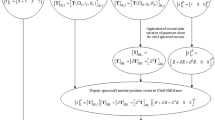Abstract
This paper presents a Hamiltonian approach to modelling spacecraft motion relative to a circular reference orbit based on a derivation of canonical coordinates for the relative state-space dynamics. The Hamiltonian formulation facilitates the modelling of high-order terms and orbital perturbations within the context of the Clohessy–Wiltshire solution. First, the Hamiltonian is partitioned into a linear term and a high-order term. The Hamilton–Jacobi equations are solved for the linear part by separation, and new constants for the relative motions are obtained, called epicyclic elements. The influence of higher order terms and perturbations, such as Earth’s oblateness, are incorporated into the analysis by a variation of parameters procedure. As an example, closed-form solutions for J2-invariant orbits are obtained.
Similar content being viewed by others
References
K. Alfriend H. Schaub (2000) ArticleTitle‘Dynamics and control of spacecraft formations: challenges and some solutions’ J. Astronaut. Sci. 48 IssueID2 249–267
Alfriend, K. and Yan, H.: (2002), ‘An orbital elements approach to the nonlinear formation flying problem’, In: International Formation Flying Symposium, Toulouse, France.
Battin, R.: (1999), An Introduction to the Mathematics and Methods of Astrodynamics, AIAA.
Born G.H. (2001). ‘Motion of a Satellite under the influence of an Oblate Earth’. Technical Report ASEN 3200. University of Colorado, Boulder.
T. Carter M. Humi (1987) ArticleTitle‘Fuel-optimal rendezvous near a point in general Keplerian orbit’ J. Guidance, Control Dynam. 10 IssueID6 567–573
W. Clohessy R. Wiltshire (1960) ArticleTitle‘Terminal guidance system for satellite rendezvous’ J. Astronaut. Sci. 27 IssueID9 653–678
M. Efroimsky P. Goldreich (2003) ArticleTitle‘Gauge symmetry of the N-body problem in the Hamilton–Jacobi approach’ J. Math. Phys. 44 5958–5977 Occurrence Handle10.1063/1.1622447
M. Efroimsky P. Goldreich (2004) ArticleTitle‘Gauge freedom in the N-body problem of celestial mechanics’ Astron. Astrophys. 415 1187–1899 Occurrence Handle10.1051/0004-6361:20034058
Gim, D. and Alfriend, K.: (2001), ‘The state transition matrix of relative motion for the perturbed non-circular reference Orbit’, In: Proceedings of the AAS/AIAA Space Flight Mechanics Meeting, Santa Barbara, CA.
Goldstein, H.: (1980), Classical Mechanics. Addison-Wesley.
P. Gurfil N. Kasdin (2004) ArticleTitle‘Nonlinear modeling and control of spacecraft relative motion in the configuration space’ J. Guidance, Control, Dynam. 27 IssueID1 154–157
G. Hill (1878) ArticleTitle‘Researches in the lunar theory’ Am. J Math. 1 5–26
G. Inalhan M. Tillerson J. How (2002) ArticleTitle‘Relative dynamics and control of spacecraft formations in eccentric orbits’ J. Guidance, Control Dynam. 25 IssueID1 48–60
Karlgaard, C. and Lutze, F.: (2001), ‘Second-order relative motion equations’. In: Proceedings of the AAS/AIAA Astrodynamics Conference, Quebec City, Quebec.
Kasdin, N. and Gurfil, P.: (2004), ‘Hamiltonian modeling of relative motion’. In: E. Belbruno, D. Folta and P. Gurfil (eds.), Astrodynamics, Space Missions, and Chaos, The Annals of the New York Academy of Sciences, Vol. 1017.
F. Namouni (1999) ArticleTitle‘Secular interactions of coorbiting objects’ Icarus 137 293–314 Occurrence Handle10.1006/icar.1998.6032
H. Schaub K. Alfriend (2001) ArticleTitle‘J2 invariant relative orbits for spacecraft formations’ Celes. Mech. Dynam. Astron. 79 77–95 Occurrence Handle10.1023/A:1011161811472
H. Schaub S. Vadali K. Alfriend (2000) ArticleTitle‘Formation flying control using mean orbital elements’ J. Astronaut. Sci. 48 IssueID1 69–87
D. Scheeres F. Hsiao N. Vinh (2003) ArticleTitle‘Stabilizing motion relative to an unstable orbit: Applications to spacecraft formation flight’ J. Guidance, Control Dynam. 26 IssueID1 62–73
Vinti J.P. (1998). Orbital and Celestial Mechanics, Progress in Astronautics and Aeronautics, Vol. 177, AIAA.
Author information
Authors and Affiliations
Corresponding author
Rights and permissions
About this article
Cite this article
Kasdin, N.J., Gurfil, P. & Kolemen, E. Canonical Modelling of Relative Spacecraft Motion Via Epicyclic Orbital Elements. Celestial Mech Dyn Astr 92, 337–370 (2005). https://doi.org/10.1007/s10569-004-6441-7
Received:
Accepted:
Issue Date:
DOI: https://doi.org/10.1007/s10569-004-6441-7




